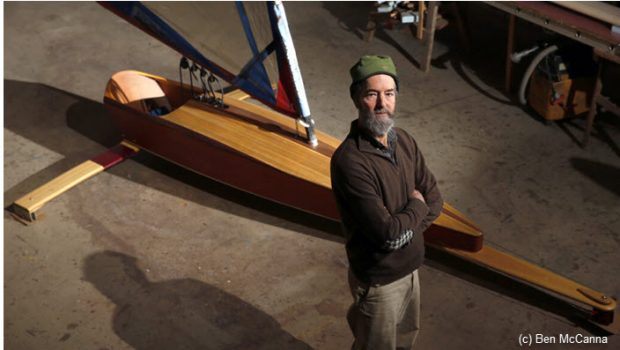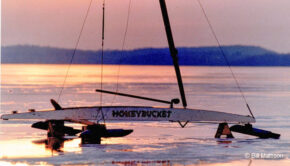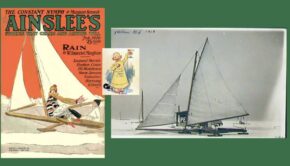Boat builder stands out in the crowd
Published on February 7th, 2019
The boatbuilding craftsmanship in Maine is legendary, a skill that’s passed down from one generation to the next. It’s hard to calculate how many builders are in the state where there’s a mix of established names with large production runs and international recognition, as well as many small, boutique-style companies.
Among this crowd is Bill Buchholz who builds ice boats for a living. Buchholz is the only full-time commercial ice-boat builder in Maine, and one of a small number in the country.
He built his first in 2007, and in the subsequent years turned his Camden (ME) company, Apache Boatworks, into a business that specializes in ice boats, sleek usually one-person crafts that can skate across frozen ponds and lakes at speeds over 100 mph.
“Worldwide, ice boating is esoteric,” admitted Buchholz, wearing a bright green ski hat while working in his shop surrounded by vintage ice- boat posters and photographs. “You’re not quite a lunatic but it’s a fringe activity. If it’s not on your radar, you’re not likely to discover it.”
Some clubs in the Midwest and the Northeast have offered ice boating as far back as the mid to late 1800s. The Rockland-based Chickawaukie Ice Boat Club – the only ice-boating club in Maine – has been around only since the 1960s, starting as a racing club and evolving into more of a touring and cruising tribe.
Members gather on large lakes as many as 30 times a year when weather permits and cover as much as 100 miles in a day. However, Buchholz notes how the sport has waned nationwide, and today it’s not as popular in the United States as it has remained in Canada and Europe.
In the heyday of ice boating, many more boat builders built and sold ice boats, so it’s not surprising that many antique ice boats built a century ago are still used by enthusiasts to race and tour. For many sailors, in fact, the used market is the only way to get an ice boat today. Or they may take a DIY approach.
“As far as I know, most ice boats are still home-built,” said Jim Gagnon, the treasurer of the Rockland-based club. “Bill’s shop is the only one I know of in Maine.”
In his cavernous, still-unfinished boat shop in the Camden woods, Buchholz has eased toward retirement, focusing more and more on custom-made ice boats. He worked in boat yards for more than 20 years before opening Apache Boatworks, down the hill from his house, 10 years ago. Since 2007, he’s built 21 ice boats; they now constitute half the boats he builds.
“I didn’t plan on that,” he said. “It’s just a fun thing to do.”
The prices range widely. Buchholz’s ice boats sell for as little as $3,000 and as much as $25,000. The sport, Buchholz said, “does not have to be expensive.” The higher-end boats have higher-end parts, such as carbon fiber masts that Buchholz builds himself by wrapping the shaped wood in sheets of carbon fiber and baking it in an oven, a tedious process that must be done just right.
Some of the boat designs he uses date back to the early 1900s. Others are newer designs, like the mini skeeter that was developed four years ago.
In 2015, Buchholz attempted a European monotype design that came out of Estonia in 1932. The design became so popular that a large regatta honoring it is held in Europe every year – it’s considered the Monotype world championship.
When the small European community of ice boaters heard Buchholz was building one, they invited him to the race and lent him a boat to race himself. He didn’t win but relished the experience, racing with a partner from Russia who spoke no English.
Buchholz’s shop has two long work benches, saws and drills of all sorts, and metal cases with dozens of drawers containing nails, screws, bolts and other ice-boat hardware, all carefully labeled. Over the years he has built every part of an ice boat: the hull, the mast, the runners (where the blades go). Sometimes he contracts out to other builders for specific parts.
He also finds used parts that he can use online. This winter he used a second-hand sail that, though originally used by a wind surfer, worked perfectly for the ice boat he was building for a new member of the Chickawaukie Club, Katie Cousins of Hancock, New Hampshire.
Cousins wanted a boat she could handle that kept her nicely tucked inside the cockpit. She looked at used ice boats, but most were the traditional DN model, which felt too big and left her too exposed.
Then she met Buchholz at a Chickawaukie Club meeting. He told her about the mini skeeter design and said he could tailor an ice boat to her specifications. Better yet, the price tag wouldn’t frighten her.
He built her hull out of plywood, cutting a frame first, and finishing with mahogany and white cedar that he sanded smooth to show the variations in the wood grain, then shellacked. He built a matching plank to hold the runners for the 12.5-foot-long boat. The entire process took 50 to 60 hours. “This one went quick,” Buchholz said.
Finally, he outfitted the boat with a used mast, boom and sail, and second-hand blades. The boat came in at the lower end of his range, Buchholz said.
“When I went to get it last weekend, it was amazing,” she said. “The different tones in the wood are so beautiful. And it’s small. Without the plank it weighs only about 50 to 55 pounds. It’s a perfect fit.”
She tested her new boat in huge gusty winds last weekend – it hit the mark, she said enthusiastically.
Buchholz takes great satisfaction in building ice boats that fit the individual boater and handle well.
“Everyone asks how fast they go and that’s the wrong question,” Buchholz said. “I don’t build them as much for speed as overall performance.”
Source: www.pressherald.com








 We’ll keep your information safe.
We’ll keep your information safe.